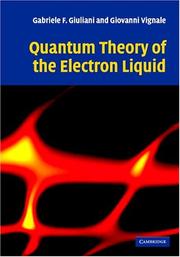| Listing 1 - 3 of 3 |
Sort by
|
Book
ISSN: 01607642 ISBN: 0821832506 9780821832509 Year: 2005 Volume: 104 Publisher: Providence, R.I. American Mathematical Society
Abstract | Keywords | Export | Availability | Bookmark
 Loading...
Loading...Choose an application
- Reference Manager
- EndNote
- RefWorks (Direct export to RefWorks)
"This book is directed toward readers who are interested in learning about the Newtonian N-body problem, as well as toward students and experts in this area who are interested in new expositions of past results, previously unpublished research conclusions, and new research problems. As many readers will have no previous knowledge about this fascinating area, each chapter starts with introductory material that is motivated by unanswered research questions, includes some history with an occasional anecdote, provides discussions intended to develop intuition, introduces new technical approaches that answer open questions, and raises unsolved research problems. The first chapter, for instance, starts with simple explanations of the apparent "looping" orbit of Mars and the unexpected "Sunrise, Sunset" behavior as viewed from Mercury, to lead up to the unexplained and weird dynamics exhibited by Saturn's F-ring. The second chapter, which introduces a way to decompose the velocity of the system, is motivated by a seemingly easy but unanswered conjecture involving the dynamics of the system when the system's diameter is a constant. The third chapter, which describes questions about the structure of the rings of Saturn, introduces new and surprisingly simple ways to find configurations of the particles that are "central" to any discussion of the N-body problem, or even about those expanding cracks in a car's windshield. The fourth chapter analyzes collisions, while the last chapter discusses the likelihood of collisions and other events."--Jacket.

ISBN: 9780511619915 9780521821124 9780521527965 051161991X 9780511410260 0511410263 0521821126 0521821126 0521527961 1107174457 1281717398 9786611717391 0511409729 0511408390 0511407629 0511409206 Year: 2005 Publisher: Cambridge Cambridge University Press
Abstract | Keywords | Export | Availability | Bookmark
 Loading...
Loading...Choose an application
- Reference Manager
- EndNote
- RefWorks (Direct export to RefWorks)
Modern electronic devices and novel materials often derive their extraordinary properties from the intriguing, complex behavior of large numbers of electrons forming what is known as an electron liquid. This book provides an in-depth introduction to the physics of the interacting electron liquid in a broad variety of systems, including metals, semiconductors, artificial nano-structures, atoms and molecules. One, two and three dimensional systems are treated separately and in parallel. Different phases of the electron liquid, from the Landau Fermi liquid to the Wigner crystal, from the Luttinger liquid to the quantum Hall liquid are extensively discussed. Both static and time-dependent density functional theory are presented in detail. Although the emphasis is on the development of the basic physical ideas and on a critical discussion of the most useful approximations, the formal derivation of the results is highly detailed and based on the simplest, most direct methods.
Fermi liquid theory --- Fermi surfaces --- Hartree-Fock approximation --- Many-body problem --- Quantum field theory --- Relativistic quantum field theory --- Field theory (Physics) --- Quantum theory --- Relativity (Physics) --- n-body problem --- Problem of many bodies --- Problem of n-bodies --- Mechanics, Analytic --- Hartree approximation --- Hartree-Fock-Slater approximation --- Approximation theory --- Atoms --- Energy-band theory of solids --- Self-consistent field theory --- Surfaces, Fermi --- Electrons --- Free electron theory of metals --- Quantum statistics --- Landau Fermi liquid theory --- Landau theory of Fermi liquids --- Landau's theory of Fermi liquids --- Fermi liquids

ISBN: 0521821126 Year: 2005 Publisher: Cambridge Cambridge University press
Abstract | Keywords | Export | Availability | Bookmark
 Loading...
Loading...Choose an application
- Reference Manager
- EndNote
- RefWorks (Direct export to RefWorks)
Modern electronic devices and novel materials often derive their extraordinary properties from the intriguing, complex behavior of large numbers of electrons forming what is known as an electron liquid. This book introduces the quantum theory of the electron liquid and the mathematical techniques that describe it. The electron liquid's behavior is governed by the laws of quantum mechanics which prevail over the microscopic world of atoms and molecules.
Fermi liquid theory --- Fermi surfaces --- Hartree-Fock approximation --- Many-body problem --- Quantum field theory --- 530.145 --- Quantum theory --- 530.145 Quantum theory --- Relativistic quantum field theory --- Field theory (Physics) --- Relativity (Physics) --- n-body problem --- Problem of many bodies --- Problem of n-bodies --- Mechanics, Analytic --- Hartree approximation --- Hartree-Fock-Slater approximation --- Approximation theory --- Atoms --- Energy-band theory of solids --- Self-consistent field theory --- Surfaces, Fermi --- Electrons --- Free electron theory of metals --- Quantum statistics --- Landau Fermi liquid theory --- Landau theory of Fermi liquids --- Landau's theory of Fermi liquids --- Fermi liquids
| Listing 1 - 3 of 3 |
Sort by
|

 Search
Search Feedback
Feedback About UniCat
About UniCat  Help
Help News
News